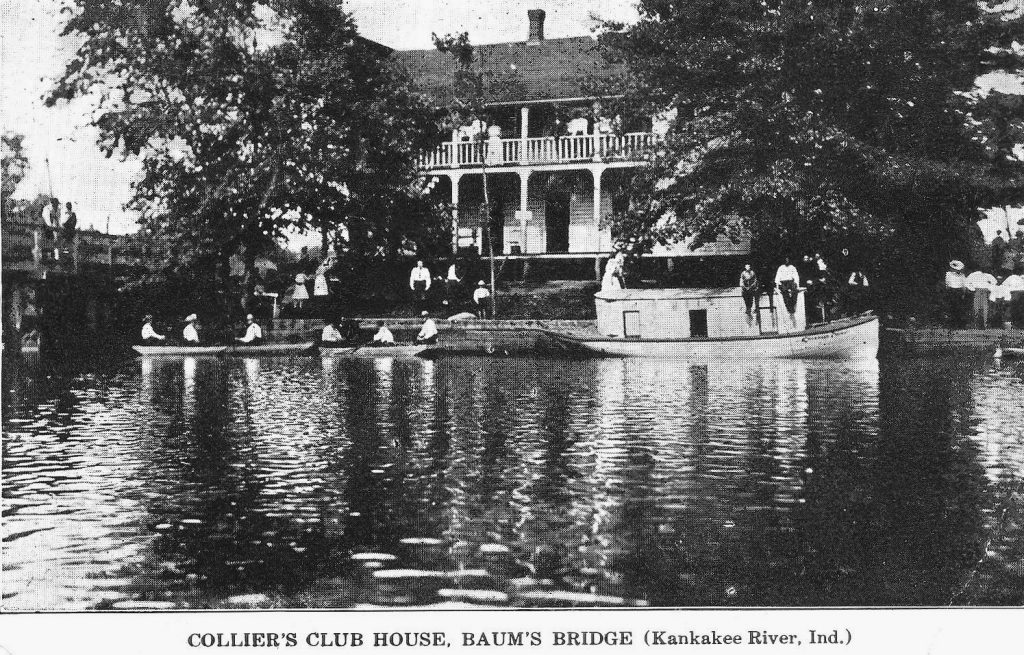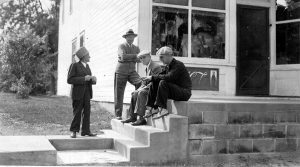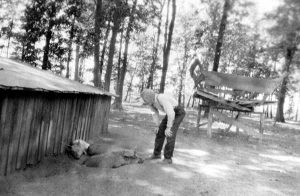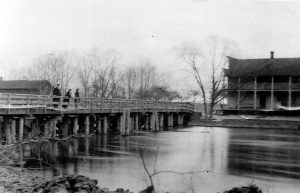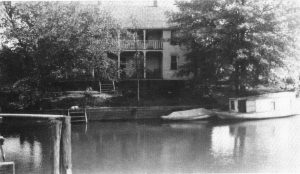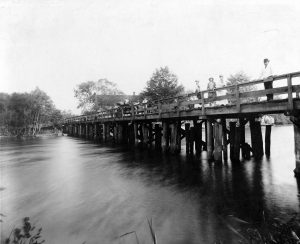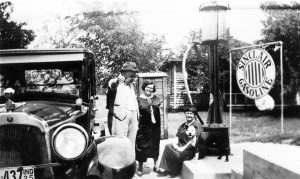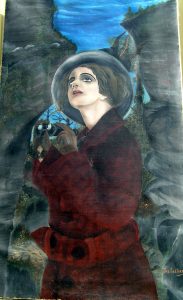By John Hodosn
Baum’s Bridge in south Porter County is widely recognized as one of the most historic spots remaining of the former Kankakee Marsh. The last structure from the Sportsmen Era (1880-1910) at Baum’s Bridge is the Collier Lodge. The Collier family was originally from Brook, Ind. Elwood Collier was born in 1858 — Flora Young in 1861. Elwood and Flora were married in Newton County, Ind in 1887. The Colliers had three children: Myrtle, Glena and James. They later adopted a girl named Helen. Glena died in 1889 and Myrtle in 1896. Both are buried in Morocco, Ind.
In 1949 Jim Collier was interviewed by the Vidette-Messenger. In the story Jim talks about the history of the Kankakee River, Baum’s Bridge and the Collier family. Jim told that his father “constructed a 35 foot cabin boat, in which to take his family to the St. Louis World’s Fair. The boat, propelled by a 20-horse power gasoline engine, was christened “Iroquois”, since it had been launched on the Iroquois River. Following the fair Collier promoted a new business enterprise by operating the Iroquois up and down the Kankakee River, making regular excursion trips from Baum’s Bridge to Momence.” Due to the unpredictable seasonal depth of the Kankakee the tour boat venture was unsuccessful.
However, that failure did not detour Elwood who was confidant of the business opportunities at Baum’s Bridge. After remodeling their home, which was located next to bridge, the Collier Lodge was born. Jim shared that the Colliers also operated a small store downstairs where they sold camping supplies and sportsman’s equipment. “Mother Collier served delicious, tempting meals to weary fishermen with ravenous appetites. Often she served chicken and fish dinners to as many as 250 persons. Dad Collier had on hand 25 or 30 boats for hire.”
Jim Collier had an artistic gift and was well known for his scenic and wildlife depictions of the old Kankakee Marsh. Although, the breathtaking beauty of the Kankakee Marsh was destroyed when the marsh was drained, Jim was able to recreate it visually through his paintings. I have only seen one of Jim’s paintings — the rest of his numerous works of art has since disappeared.
After Flora’s death in 1925, Elwood’s in 1943 and Jim’s in 1952 the Collier Lodge passed through a succession of owners until 2002 when the Kankakee Valley Historical Society took possession of the lodge. KVHS has been working to restore the historic Collier Lodge to its former glory. The Collier lodge was recently awarded a planning grant through the Office of Community and Rural Affairs. This is the first step in bringing this project from concept to reality! The Society successfully raises restoration funds through the annual Aukiki River Festival, sales of publications and other events. Grants and other funding sources are being sought.
Kankakee River’s Story Is
Recaptured By Man Who
Lives Along Its Shore
By FRANCES LONG
April 19, 1949
Vidette-Messenger
Jim Collier loves to paint! He likes to dream— to relive, by retrospection, the good old days when the Kankakee River in all its grandeur lolled just outside the door of the Collier home; when the river teemed with pike, pickerel, catfish and many other well-known species of fish, where prairie chickens, grouse, beaver, wood-ducks and other birds and animals once lived in the swamps.
Collier, “Jim” as he is known to his many friends and neighbors, has spent most of his life near what was once a natural waterway and was one of the first highways of the white man to the Mississippi river. The name of the great explorer LaSalle has always been associated with the Kankakee. LaSalle entered that region, inhabited by the Indians, much as the serpent entered the Garden of Eden. LaSalle was the first white man of record, to visit the area, coming there in a birch canoe.
It was in 1821 that white hunters first moved into the Kankakee about 10 years later the first white settlers moved in. According to history the last buffalo was killed there in 1790. Pigeons, which once clouded the sun in their flight over the swamps, disappeared a few years previous. In 1880 the last deer were reported killed, and In 1891 a veteran trapper ended his hunt for timber wolves. In 1919 a tiger was reported killed by a native of the upper Kankakee region. The authenticity of this latest report was questioned, however.
In about 1820 the river’s name was registered by a Major Long as the “Kankakee’, and oldest accounts of its origin have the name derived from the Indian word A-Ki-KI, or “Wolfland”. The river then spread in width from two to 15 miles and was dotted by hundreds of wooded islands where the Indians fished, trapped and hunted.
Young Jimmy Collier listened to these interpretations of early life along the Kankakee river and began to draw mental pictures of beautiful Indiana princesses and stalwart princes, beside rainbow-colored rook and tinkling water falls. He was fascinated by the beauty of the river and he grew to love both the winged and footed creatures of the wild.
Jimmy had come here from a place vastly different in nature from that of his new home. He was brought to
Baum’s Bridge from Brook, Ind., by his parents, Mr. and Mrs. C. E. Collier. Collier had constructed a 35 foot cabin boat, In which to take his family to the St. Louis World’s Fair. The boat, propelled by a 20 horse power gasoline engine, was christened “Iroquois”, since it had been launched on the Iroquois River.
Following the fair Collier promoted a new business enterprise by operasting the Iroquois up and down the Kankakee River, making regular “excursion” trips from Baum’s bridge to Momence. Jimmy frequently accompanied his father on these trips.
However, navigation being impossible when the water was low, and the water being low a good bit of the time, finally brought this business venture to an end. Later, the boat came to an end—off the Dunes beach on Lake Michigan.
“Now,” said Mother Collier. “We’ll starve to death in this place.” But her husband knew they wouldn’t. He knew there were business opportunities there if one were ambitious enough. So, with the help of Young Jimmy, he set, about remodeling the home and in due time the work was finished and it became known as the “Collier Hotel.”
Collier also operated a small store downstairs where he sold camper’s supplies and sportsman’s equipment. Mother ‘Collier served delicious, tempting meals to weary fishermen with ravenous appetites. Oftentimes she served chicken and fish dinners to as many as 250 persons. Dad Collier had on hand 25 or 30 boats “for hire.”
Where was Jimmy—and what was he doing? Jimmy was in the remote portion of the landscape. He was drawing cartoons and caricatures. He drew pictures of his family, his friends, and the hotel guests. Some of the pictures he displayed on the front of his father’s white store. Others the public never saw.
When he was not making pictures the lad liked to hunt for arrow heads, bends, and implements of the red men’s simple agriculture.
One day while his mother was attending a ladies Bid meeting in the neighborhood he began a search for these relics in a mound near the home. Upon unearthing a bone his curiosity became aroused and he removed the remainder of the dirt and beheld the skeleton of an Indian who had apparently been buried in a sitting position. Always on the lookout for a new “model.” The youngster now had one which he termed “unique.” When Mrs. Collier returned home from the afternoon sewing bee, she found, to her utter consternation, her sons “model” gracefully occupying a conspicuous place on the front veranda, entirely devoid of flesh or clothing. As to what transpired just after that, there is no accurate or detailed account, but It Is known that the in incident came very near bringing to an abrupt end the young artist’s career as a collector.
All over the world the Kankakee was lamed as one of the really great concentration areas for water fowl. It was, without question, a fisherman’s paradise—a hunter’s dream world. Here came the nobility of Europe, a president, Grover Cleveland, the moneyed sportsmen of the aristocratic east. By Baum’s bridge General Lew Wallace worked in his houseboat on the novel “Ben Hur.” General Wallace was a regular visitor In the Collier home. Now the Collier’s son became interested in painting. He used water colors to paint river scenes. His painting soon became a hobby that he was to pursue the rest of his life. After a time he painted with oils, and now this is a favorite pastime of the hobbyist, and it is one which might eclipse any found In that Porter County region.
It was on one of these paintings that the camera caught Jim at work, on a sunny afternoon recently. In the accompanying picture he is seen with easel, palette and brushes.
Deer and other wild life come into existence under this artist’s brush Cattails lifting their brown spike heads at the edge of a bayou.
Kankakee River scenes — winter scenes, when its current appears stilled by the elements; summer scenes—when the lazy flow of the stream is most fascinating to all This artist seeks neither fame nor fortune. He is content to paint and dream. It is a very special privilege to have Jim Collier show you his paintings. In this Instance a mutual friend paved the way for an interview with the artist. Pictures were brought down from one of the upstairs rooms, where he sometimes takes his work. Often many hours are spent on a picture before it finally meets with his approval, for he Is his own severest critic.
Since the death of his parents, Collier has lived alone in the spacious rooms of the Collier home. He has continued to operate the little sporting equipment store.
The names Baum’s Bridge and Collier are closely associated. Should one inquire the way to Baum’s bridge the Information given would be something like this: take state road eight to Trinklc’s Corners. This, regardless of which end of the highway might be the starting point. Then turn south and go straight to the river. However, the word “straight” is a bit misleading. The road is beautifully winding! Before reaching the bridge the road, from a distance, appears to come to a dead end and it would seem that one would crash right into the front door of Jim’s white frame store building. But a sharp bend in the road would take the tourist to Baum’s Bridge. Built In 1863 by Enos Baum, owner of the first ferry boat there, the bridge Is only a few steps from the store. This bridge was built over the old channel of the Kankakee river, replacing the ferry at a ford on an old trail of the Pottawatomie’s who long made frequent camp there.
From detailed accounts and many narrations, a few of which have been dubiously accepted as genuine, Jim has vividly portrayed on canvas the life of the early settlers and the once beautiful river. The painting which is shown on the easel, is in its first stages now, but when finished it will be on exhibition at the Hoosier Art Salon.
Jim Collier loved the broad, winding Kankakee River and he was heartsore, as were many others, when in 1914 the natural waterway was replaced by a man-made ditch, swiftly running and straight as the Indian’s arrow. The new dredge dried up the old bayous, leaving water stagnant or to disappear entirely from the old sloughs.
”There’s not much left here,” he said as he put away palette and brushes, at the same time looking out toward the old riverbed where hundreds, yes thousands, of fishermen had whiled away many happy hours. Is it any wonder that Collier dreams as he paints?
Building the new ditch has only succeeded in reclaiming some marsh land for agriculture, the original purpose of the project. There still remain, however, thousands of acres of sub-marginal land, on what is now proposed to restore some of the Kankakee’s original wild state Already programs for reforestation, etc., are underway in Newton and
Jasper Counties.
Members of conservation clubs in other adjacent counties are becoming interested in these new projects and it is expected that, before too long parts of the Kankakee River region will regain some semblance of its lost state.
Action taken during the state legislative session in 1941 provided half of a $566,000 fund for use In developing wildlife sanctuaries and a 2,500 acre lake in the Newton and Jasper County areas of the Kankakee. When completed the lake will be the second largest in Indiana Remainder of the $558,000 fund will be used to develop a public recreation area at Wolf lake in Hammond
But the old winding river, which is known as the disappearing river will never return.
Click here for the Collier Lodge restoration study, plan and pictures


